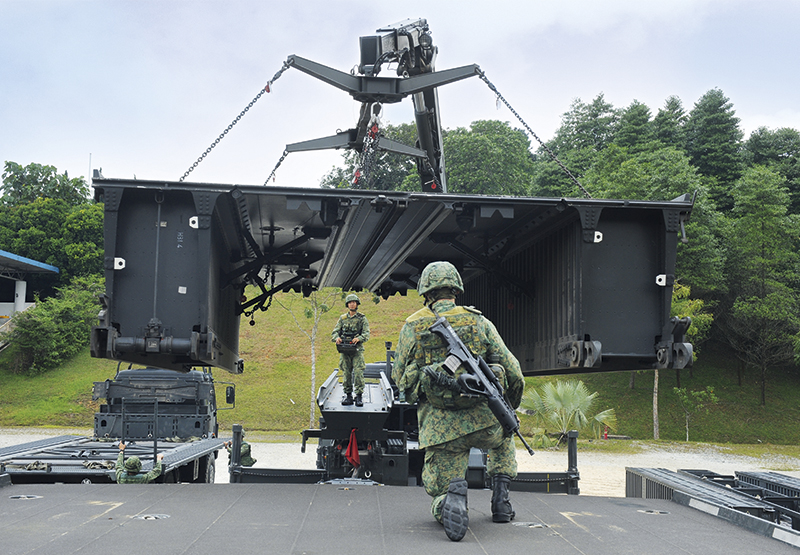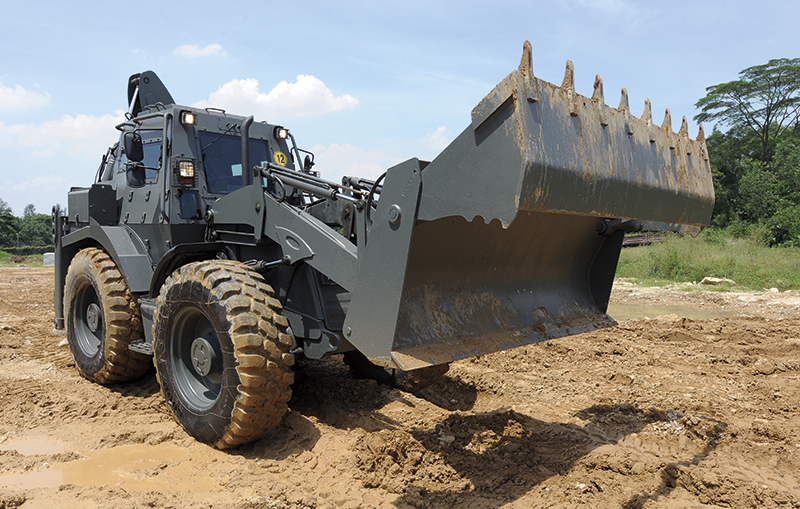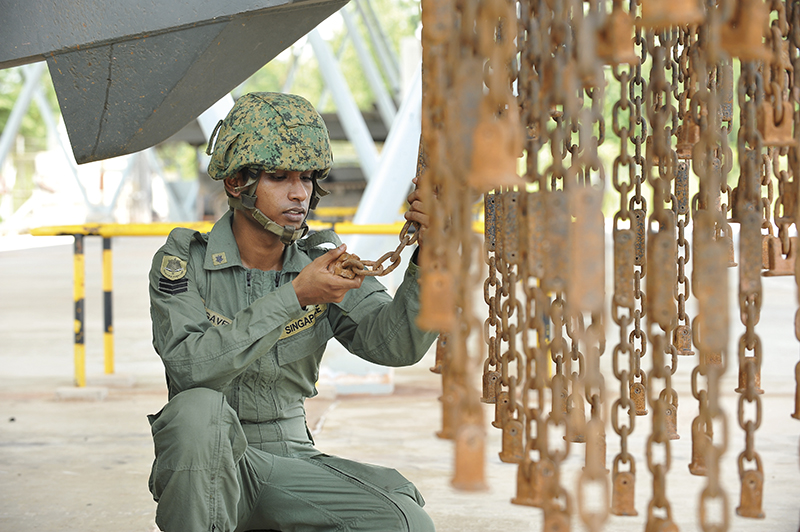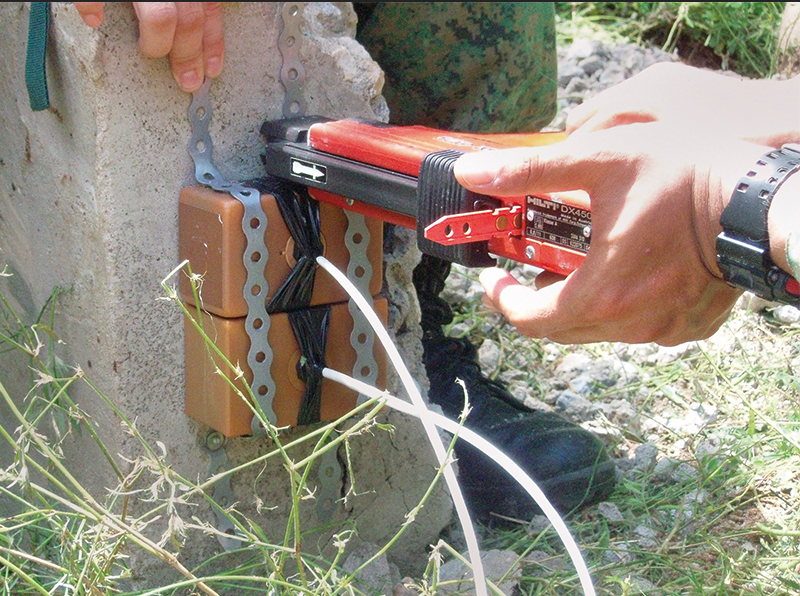OPS & TRAINING
ENGINEERS ROLL OUT!
03 Jun 2013

With their advanced equipment, the Singapore Combat Engineers (SCE) can either help troops move like greased lightning over obstacles or stop enemies dead in their tracks.
In the dead of night on a riverbank somewhere in western Singapore, a group of soldiers are hard at work. They stand on a floating metal platform, roughly the size of a tennis court, which straddles the water and the bank. Troops and vehicles load up onto the platform and the two pilots rev up the engines to turn the platform around. Slowly, the entire platform, with its load, makes its way across the river.
This is the M3G military float bridge most Singaporeans would have seen at recent National Day parades, where they were used as gun platforms for the 21-gun presidential salute. Operated by the SCE, the M3G bridge is probably the most visible of combat engineer assets in the public eye. However, these soldiers are capable of much more than ceremonial duties.
Be it punching a path through impassable terrain or laying a bridge under fire, the combat engineers always rise to the occasion when ensuring that friendly troops have access to safe passage. There is also a flip-side to the combat engineers - they are equally capable at impeding the movement of enemies.
Heavy-duty soldiers
"Packing light" is probably an alien term to combat engineers. These soldiers typically roll with equipment such as heavy-duty plants/earth-moving equipment, armoured mine-clearing vehicles and hefty bridging systems to help friendly forces advance through the worst terrain. Even field engineers (who are often on foot) pack a punch with their demolition know-how.
For example, the Trailblazer, a Counter-Mine Vehicle, is almost 7m in length and the Foldable Longspan Bridge (FLB) consists of six vehicles, each more than 10m long and 3m high.
On top of mobility and counter-mobility operations, combat engineers help troops in the Army to survive on the battlefield by constructing protective structures. They also help to defend against Chemical, Biological, Radiological and Explosives threats.
The dug-in command post is one of the largest field fortification structures constructed by the combat engineers. Designed to protect the nerve-centre of military operations and communications equipment, a command post is an entrenched structure the size of a small room.
Tech generation
Sure, it might not be the vocation which most Full-time National Servicemen (NSFs) wish upon themselves after Basic Military Training. "Tough", "back-breaking" and "hard labour" are usually the words people associate with the combat engineers. Little do they know that things have changed.
Though combat engineers are still expected to move tonnes of equipment, the way they achieve their missions is markedly different from the past.
Gone is the infamous Medium-GirderBridge (MGB), which required an entire company of soldiers literally carrying each building block (of varying weight, depending on its function and typically about 80kg) to span a gap. Constructing the MGB usually took about six hours.
In comparison, the FLB can be operated by 11 soldiers. In place of human muscle, the FLB uses a crane to help soldiers carry the load and the entire construction sequence is controlled from a pair of wireless controllers - one for the crane and the other for the launching system. A span of 45m is bridged in less than four hours.
Mundane combat engineer tasks such as the construction of field fortifications have also been enhanced by technology. The High Mobility Plant (HMP) steps in where the combat engineers used to have to dig for hours on end to entrench troops in defensive positions. With its attachments, the HMP can be used to move massive amounts of earth and break through concrete and smooth roads, saving soldiers energy to push on further afield.
Potentially risky work, such as the onerous task of checking suspicious packages for explosives are undertaken by the combat engineers from the Explosive Ordnance Disposal (EOD) unit, is made safer with the use of specialised EOD robots. These remote operating vehicles are capable of rendering safe Improvised Explosive Devices (IEDs) while the operator is a safe distance away. In the field, combat engineers from the EOD unit help ground units to render safe any IEDs which hinder their advancement.
When it comes to Chemical, Biological and Radiological (CBR) threats, the Singapore Armed Forces calls upon combat engineers of the CBR Defence unit. Using HazMatID (hazardous material identification) devices and protective suits, these engineers are mobilised to pinpoint the source of CBR threats and to neutralise them.
We take a closer look at some of the advanced machines operated by the combat engineers.
1. Foldable Longspan Bridge
Each bridge section of the FLB unfurls like metal origami. In its expanded form, the top of each bridge part forms a wide roadway for vehicles and troops. A 11-man platoon can bridge a gap of 45m in under four hours.
"Compared to its predecessor, the MGB, the FLB is definitely much faster and more efficient," said 2nd Lieutenant (2LT) Ng Wei Lun, Platoon Commander, FLB Platoon.
During construction, the crew has to work in unison. The bridge parts (which sit atop five transporter vehicles) have to be driven to the crane in the correct sequence so that the crane operator can bring the right parts for the launching system operator to couple. Coordination between the crane operator and launching system operator, both specialists, has to be especially tight.
"It's like Lego; I bring the parts to the launching beam and the Launch Commander moves the parts and joins them together," said 3SG Liu Shao Xing, Crane Commander, FLB Platoon. During construction, he usually stands on a platform of the launching vehicle, which may be more than 2m off the ground. The launching vehicle has to be jacked up in order to compensate for the sag of the bridge as it inches towards the opposite bank.
On the ground, the rest of the 11-man platoon help to ensure that all the parts are connected properly and to make minor adjustments. "At first, we found the system quite daunting due to its size, but once we were trained and knew how the entire bridge worked, it became easier," said 3SG Brown Jeryd Navarone, Launch 2nd-in-charge, FLB platoon.
The results of their training are also reflected in their construction timings. "When we started out on the FLB, we could take more than four hours to complete (the bridge).
"Nowadays, we do it in less than four," said 3SG Brown.
2. M3G Military Float Bridge/Raft
Its walk is a little ungainly until the M3G hits the water. Then, the iron giant unfolds to link up with other M3Gs to form a stable platform. Known as "coupling", this process can go on until a continuous bridge is formed all the way to the opposite bank. Two M3Gs can also be coupled together to form a raft which is then used to ferry troops, equipment and vehicles from point to point.
Operated by an eight-man crew, the M3G can be deployed in less than 20 minutes. "It takes about seven weeks to learn how to operate the M3G. During the course, we spend around six weeks learning about the M3G itself," explained 3rd Sergeant (3SG) Edmond Chua, M3G Raft Commander, 35th Battalion SCE (35 SCE).
"Once the M3Gs are in the water, we set the ramps and the pilots will steer (the M3Gs) together. It s quite simple once you get the hang of it."
Once an M3G is deployed, the crew stays on board to pilot and guide vehicles on board. "It's a huge platform and because we are sitting in water, we have to be extra vigilant (to make sure everyone is safe)," added 3SG Chua.
This also means ensuring adequate food and water on board as the crew can be required to stay on the raft for as long as 12 hours. Carrying up to three five-ton trucks, the M3G can manoeuvre in waters as shallow as 1.05m and attain a top speed of 9kmh when fully laden.
3. Leopard 2 Armoured Vehicle Launched Bridge
With its crew safe within its thick hide, this armoured behemoth has a fully-automated bridge that can be placed over gaps effortlessly in five minutes. Retrieval takes just 10 minutes.
"Unlike older armoured bridges, the Leopard 2 Armoured Vehicle Launched Bridge (L2 AVLB) launches with a sliding action which gives it a lower profile and makes us less likely to draw enemy fire," explained 3SG Christopher Teow, Vehicle Commander L2 AVLB, Mechanised Engineer Company (MEC).
Its predecessor, the M-60 AVLB, used a "scissor" launching mechanism, which meant a much higher launching profile. The bridge of an M-60 AVLB can reach the height of a five-storey building when launching.
"Where the M-60 AVLB required more vertical clearance, the L2 AVLB can be deployed even under dense (forest) canopy," said Captain (CPT) Daniel Sim, Officer Commanding, MEC, 38 SCE.
"It is also equipped with the latest Battlefield Management System to enhance the situational awareness of the crew to better support our manoeuvre forces."
Training to operate the L2 AVLB first involves learning to drive the beast. "The bridge extends beyond the vehicle, so initially it was quite difficult to drive it. At first, driving it was scary; the vehicle has a huge amount of power that allows us to go up to 70kmh on cross-country terrain!" said 3SG Teow.
All MEC crew are specialists (soldiers holding the rank of 3SG and above) as they are required to operate independently with the rest of the force. "They need to be able to understand the mission and operate in integrated operations with manoeuvre units, hence MEC crew are all specialists," said CPT Sim.
4. High Mobility Plant
Like a tractor on steroids, the HMP is a five-in-one multi-tasking wonder. Armed with a two-tonne front hoe which can be switched out for a forklift attachment, the HMP also functions as a compactor, breaker, dozer and an earth auger.
"In the past, we had to bring out many different machines to accomplish what the HMP can do," said 1SG Pradeep s/o Karipahyah, Plant Engineer, Headquarters Army Combat Engineers Group.
The 11.6 tonne HMP is armoured against small-arms fire. "I feel very well-protected in the HMP and there's this sense of power when you are operating it and lifting these massive weights or moving an enormous amount of earth," said 1SG Pradeep.
Like others, when he heard of his posting to the combat engineers, he was apprehensive. "My friends all said 'siao liao' (meaning you re doomed ), you're going to be in for a tough time," laughed 1SG Pradeep.
"Once I settled in, I realised I liked being a combat engineer because I'm always learning about new equipment."
The 24-year old liked it so much, he signed on as a Regular in 2009. "In my short five years with the Engineers, I can see that we (the Formation) are becoming more advanced and we are operating more machines and learning new things so that we can work better and faster."
5. Trailblazer, a Counter-Mine Vehicle
This bizarre-looking machine is truly a time-saver. The Trailblazer bludgeons through a minefield with its 72 hammer-tipped chains. Clearing a 100m path takes a Trailblazer crew just five minutes.
"Each head strikes the ground with 1.7 tonnes of force. That (force) is more than what typical mines can withstand. When the striker heads hit, the mines are completely destroyed, detonated or simply thrown out of the path," explained 3SG Logavel Balakrishnan, MEC, 38 SCE.
In the past, the manual method of mine-prodding would have taken an entire field engineer platoon about half a day to clear the same 100m. "Manual mine-clearing might also not be 100 percent reliable because there is always a margin of human error," said 3SG Jhomel Loh, MEC, 38 SCE.
The manual method of mine clearing also involves marking out the cleared path. On the Trailblazer, that job is done by a drum of pneumatically-fired rods on each side of the vehicle. As the Trailblazer flails the ground, the brightly-coloured rods are fired into the ground to mark out the cleared path.
"I think the efficiency of the Trailblazer speaks for itself. It's a lot faster and a lot less risky for the soldiers," said 3SG Logavel.
You shall not pass
How the combat engineers use their explosive know-how to stop enemy forces from advancing
Using simple equipment such as detonation cords and detonating caps, the combat engineers can rig up an ambush to stop enemy convoys from reaching their destination. Typically carried out by the field engineers, it involves a series of explosive charges designed to stop even armoured vehicles dead in their tracks.
Here are some of the explosive charges which enemy forces won't want to see in their paths.
1. Explosive charges
Using various demolition techniques and explosive charges, the Combat Engineers are able to slow the advance of enemy forces by destroying bridges and buildings in their path.
2. Anti-vehicular charge
An area-effect device, this crescent-shaped block fires hundreds of hexagonal pellets when detonated, to stop enemy vehicles.
Engineers on the battlefield
Skilled in advancing and impeding troop movements, combat engineers can make life easier for friendly soldiers or a living hell for opposing forces.
HISTORY 101
How the combat engineers began
The story of the Combat Engineer Formation began in 1967 when the Ministry of Interior and Defence (pre-cursor to today s Ministry of Defence) set up infrastructure for an Engineer Training Wing. In the same year, the Singapore Armed Forces (SAF) sent two young officers, 2nd Lieutenant (2LT) Gurcharan Singh and 2LT Chng Teow Hua, to attend an engineer officers course in Fort Belvoir located in the United States.
In 1968, the two officers returned and the Formation conducted their first Engineer Commanders Course. The course graduates then went on to form the nucleus of the Singapore Combat Engineers and the Formation has never looked back since.
ALSO READ IN OPS & TRAINING
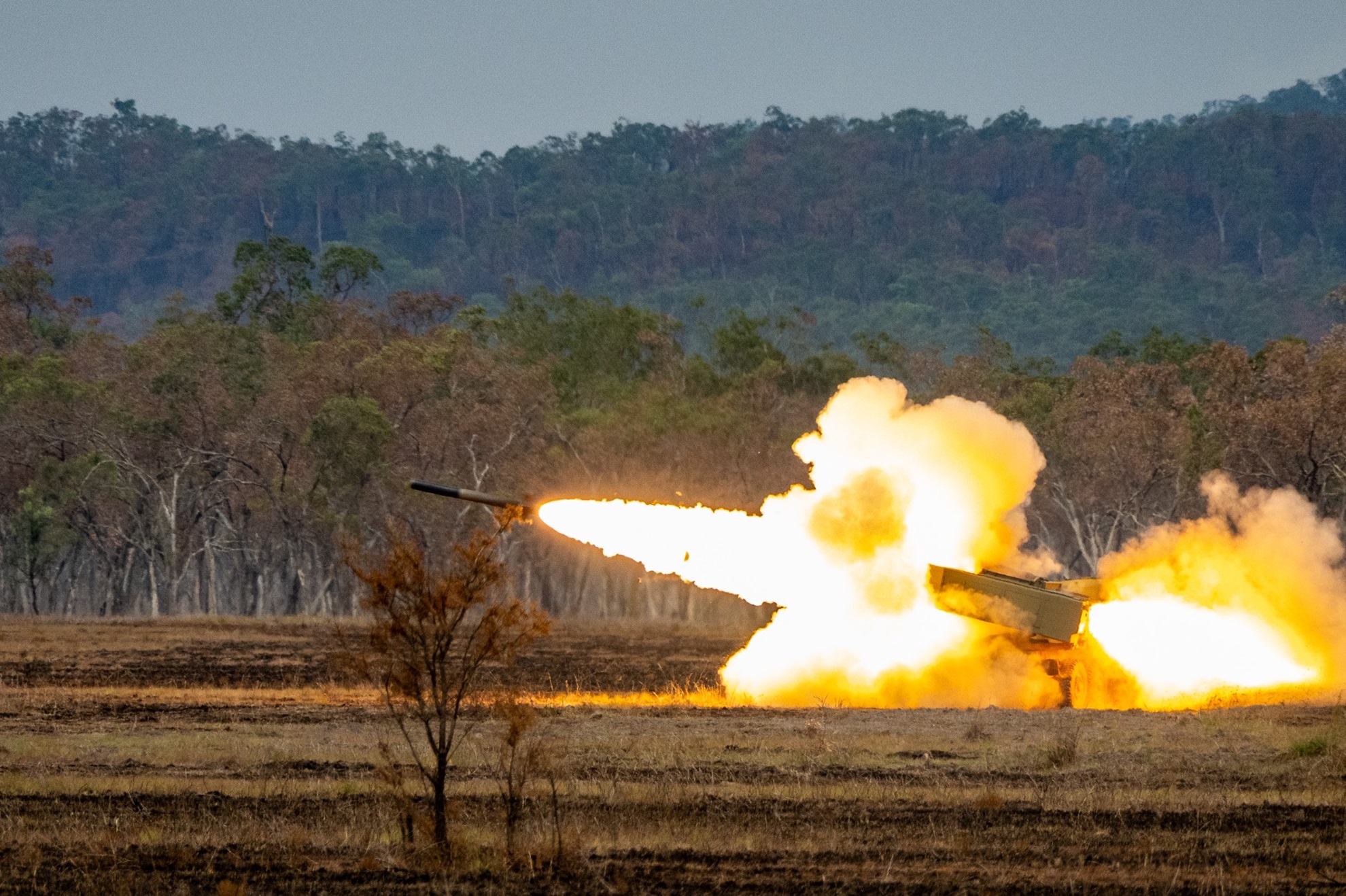
Exercise Wallaby 2025: To see better, shoot faster
31 Oct 2025
The SAF focuses on complex strike missions and multi-domain integration in Exercise Wallaby 2025, the 35th edition of its largest unilateral overseas exercise.
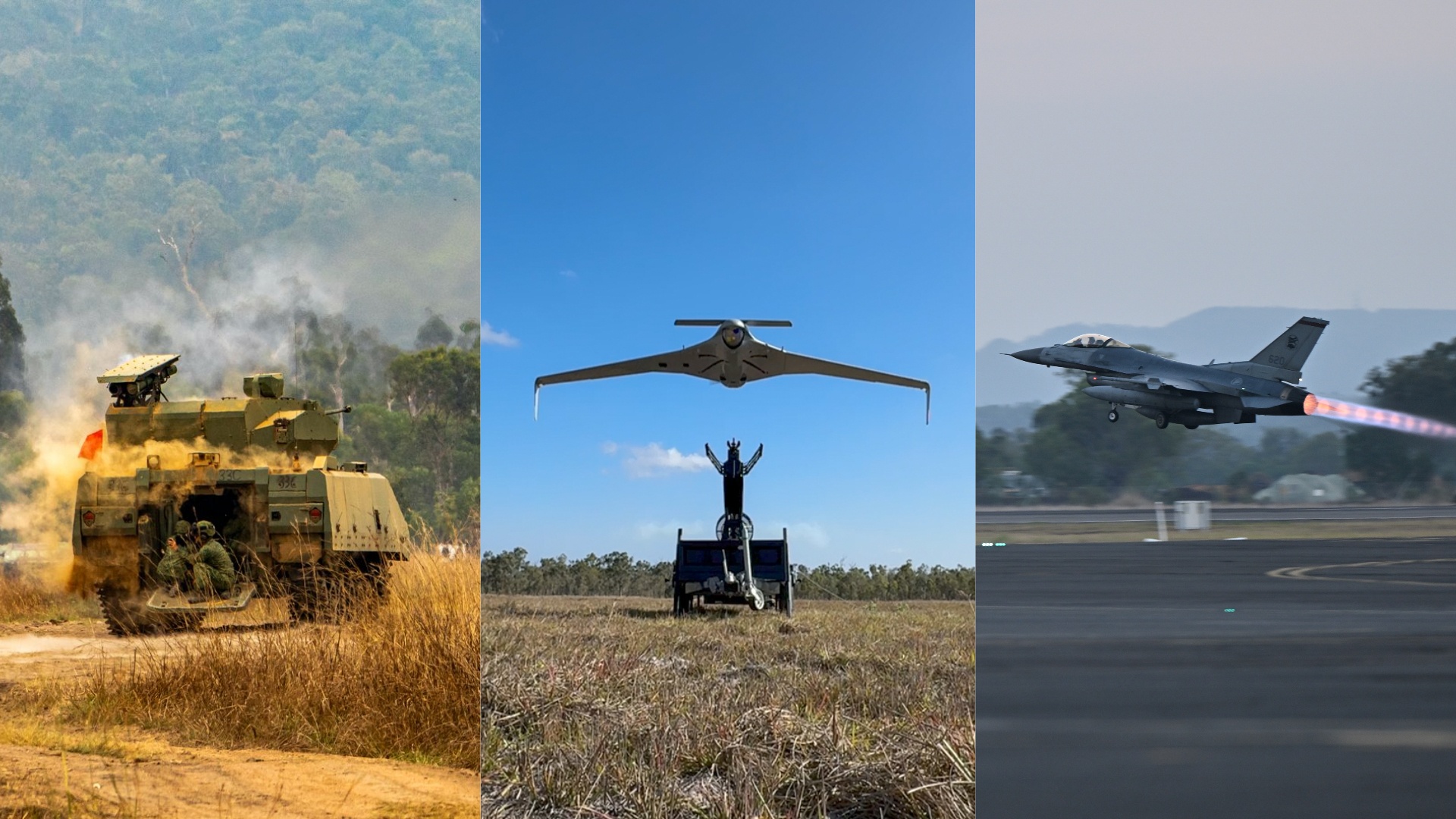
Ex Wallaby 25 – Greater Integration and Complexity
25 Oct 2025
The 35th edition of the SAF’s largest unilateral overseas exercise is an opportunity for expanded scale and deeper integration towards an effective, networked fighting force.

Ex Forging Sabre ramps up use of unmanned assets in integrated strike operations
12 Sep 2025
In this 10th edition of Exercise Forging Sabre, the SAF sharpened its cutting edge for the dynamic modern battlefield, with expanded integration between manned and unmanned platforms.


